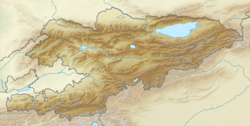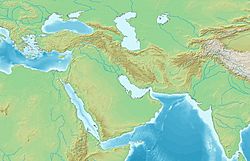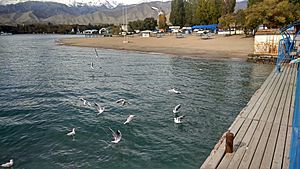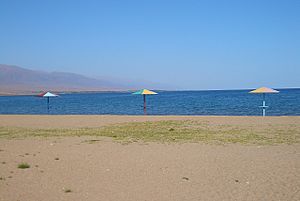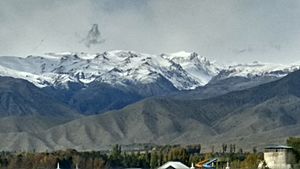Issyk-Kul facts for kids
Quick facts for kids Issyk-Kul |
|
|---|---|
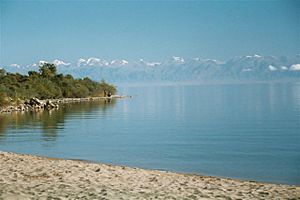
Southern shore of Issyk-Kul, 2005
|
|
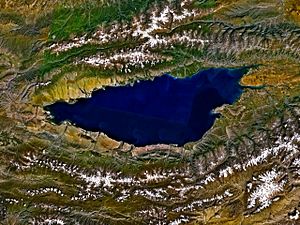
Issyk-Kul from space, September 1992
|
|
| Coordinates | 42°25′N 77°15′E / 42.417°N 77.250°E |
| Lake type | Ancient lake, Endorheic Mountain lake Monomictic |
| Primary inflows | Glaciers |
| Primary outflows | Evaporation |
| Catchment area | 15,844 square kilometres (6,117 sq mi) |
| Basin countries | Kyrgyzstan |
| Max. length | 178 kilometres (111 mi) |
| Max. width | 60.1 kilometres (37.3 mi) |
| Surface area | 6,236 square kilometres (2,408 sq mi) |
| Average depth | 278.4 metres (913 ft) |
| Max. depth | 668 metres (2,192 ft) |
| Water volume | 1,736 cubic kilometres (416 cu mi) |
| Residence time | ~330 years |
| Salinity | 6g/L |
| Shore length1 | 669 kilometres (416 mi) |
| Surface elevation | 1,607 metres (5,272 ft) |
| Settlements | Cholpon-Ata, Karakol |
| Official name: The Issyk-kul State Nature Reserve with the Issyk-kul Lake | |
| Designated: | 12 November 2002 |
| Reference #: | 1231 |
| 1 Shore length is not a well-defined measure. | |
Issyk-Kul (also called Ysyk-Köl) is a large lake in the Tian Shan mountains of Eastern Kyrgyzstan. It is an endorheic lake, which means it has no rivers flowing out of it. Issyk-Kul is one of the deepest lakes in the world and also one of the largest by volume. It is the second-largest salty lake on Earth, after the Caspian Sea.
The name "Issyk-Kul" means "warm lake" in the Kyrgyz language. Even though it is high up in the mountains (about 1,607 meters or 5,272 feet above sea level) and winters are very cold, the lake rarely freezes. This is because its water is a bit salty.
This lake is very important for nature. It is a Ramsar site, which means it is a wetland of international importance. It is also part of the Issyk-Kul Biosphere Reserve, protecting its amazing biodiversity (all the different kinds of plants and animals).
Contents
Geography of Issyk-Kul Lake
Issyk-Kul Lake is about 182 kilometers (113 miles) long and up to 60 kilometers (37 miles) wide. Its total area is about 6,236 square kilometers (2,408 square miles). It is the second-largest mountain lake in the world, right after Lake Titicaca in South America. The lake is very deep, reaching about 668 meters (2,192 feet) at its deepest point.
Many rivers and streams, around 118 of them, flow into the lake. The biggest ones are the Jyrgalang and Tüp rivers. The lake gets its water from springs, including hot springs, and from melting snow. No rivers flow out of Issyk-Kul. However, some scientists think that the lake's water might slowly seep deep underground and eventually reach the Chu River. The bottom of the lake has a special mineral called monohydrocalcite.
The southern side of the lake is bordered by the beautiful and rugged Teskey Ala-Too Range of the Tian Shan mountains. Many streams start in these mountains and flow into Issyk-Kul. On the northern side, the Kungey Alatau mountains run alongside the lake. The rivers from these northern mountains are smaller and flow directly into Issyk-Kul or the Tüp River.
The water in Issyk-Kul is slightly salty, about 0.6% salt. To compare, typical seawater is about 3.5% salt. The lake's water level is slowly dropping by about 5 centimeters (2 inches) each year. This is partly because some water is taken for other uses. The lake and the land around it are part of the Issyk-Kul Region in Kyrgyzstan.
Visiting Issyk-Kul: Tourism and Cities
During the time of the Soviet Union, Issyk-Kul was a very popular place for holidays. Many hotels and vacation homes were built along its northern shore, especially near the town of Cholpon-Ata. After the Soviet Union ended, these places faced tough times. But now, many hotels are being fixed up, and people are offering private rooms for visitors. This brings new life to the area for health and fun trips.
The city of Karakol is located near the eastern end of the lake. It is the main city of the Issyk-Kul Region. Karakol is a great starting point for exploring the nearby mountains and nature. In Karakol, you can see an amazing wooden mosque built by the Dungan people without using any metal nails. There is also an old wooden Orthodox church.
History of Issyk-Kul
Issyk-Kul Lake was an important stop on the Silk Road. This was a famous ancient trade route that connected the Far East with Europe. A famous Chinese Buddhist monk named Xuanzang visited this lake in the 7th century and wrote about it in his travel book. The lake and the land around it were once part of China, but later became part of Russia.
Many historians believe that the Black Death, a terrible disease that spread across Europe and Asia in the 1300s, might have started near Issyk-Kul Lake. In 2022, scientists found evidence that the plague was present there in 1338 or 1339. It seems the disease first infected people in a small trading village nearby. From there, it traveled along the trade routes with merchants, who unknowingly carried infected vermin (like rats and fleas) with them. This allowed the plague to spread widely.
Divers have found the remains of old settlements under the shallow waters of the lake. In 2007, a team of historians from Kyrgyzstan announced that they had found parts of a 2,500-year-old advanced civilization at the bottom of the lake. They found strong walls, some as long as 500 meters (1,640 feet), and signs of a large city. Other discoveries included ancient burial mounds and many well-preserved items. These items included bronze battleaxes, arrowheads, daggers, tools used by metalworkers, and even money. They also found what might be the world's oldest coins: gold wire rings and a large six-sided gold piece. A bronze pot was also found, made with such skill that it would be hard to copy even today.
Environment and Wildlife
Protected Areas and Nature
The first nature reserve in Kyrgyzstan, the Issyk-Kul State Reserve, was created in 1948. Its goal was to protect the unique natural areas and waterfowl (birds that live near water) of Issyk-Kul. In 1975, it was recognized as a Ramsar site, which means it is a wetland of international importance. In 2000, the Issyk-Kul Biosphere Reserve was set up by UNESCO. This reserve helps protect the amazing natural environment of the entire region.
Fish and Aquatic Life
The lake is home to many unique kinds of fish, some of which are found nowhere else in the world. Sadly, some of these species are now in danger. In recent years, the number of fish caught has gone down a lot. This is because of too much fishing, and because two types of fish that were brought into the lake (pike perch and rainbow trout) eat many of the native fish. Also, fewer young fish are being put back into the lake from special fish farms. At least four types of fish that are important for fishing are now listed as endangered in Kyrgyzstan.
The Sevan trout, a fish from Lake Sevan in Armenia, was brought to Issyk-Kul in the 1970s. While this fish is endangered in its home lake, it has done very well in Lake Issyk-Kul. However, it has caused problems for the fish that naturally live in Issyk-Kul.
The Dead Lake
There is a smaller lake near the southwest side of Issyk-Kul, which is called the Dead Lake (or Tyz Köl in Kyrgyz). It is called this because it has a very high salt content. Swimming in the Dead Lake is a very different experience from swimming in less salty water. The water in this lake comes from small cold springs on the beach. The cold, less salty water tends to stay on top, while the salty, heavy water below is often surprisingly warmer than the surface.
Legends of Creation
An old legend tells how Issyk-Kul Lake was formed. It says that a king had donkey's ears and kept them a secret by killing his barbers. One barber couldn't keep the secret and yelled it into a well. But he forgot to cover the well afterward. The water from the well then rose and flooded the entire kingdom, creating the lake we see today. Other legends say that four ancient cities are hidden at the bottom of the lake. As mentioned earlier, archaeologists have indeed found signs of old human-made structures in the shallow parts of the lake.
During the Soviet period, the Soviet Navy used a large facility at the eastern end of the lake. Here, they tested technology for submarines and torpedoes. In 2008, it was reported that Russia would lease an area on the lake for new naval testing facilities. This is part of an agreement between Kyrgyzstan and Russia. The Russian military pays for this lease. India also plans to use this facility to test different types of torpedoes and underwater vehicles. One good thing about this testing center is that the torpedoes can be recovered after being fired. This allows scientists to study them closely.
Towns Around the Lake
Here are some towns and villages around Issyk-Kul Lake, listed as you would find them if you traveled clockwise from the western tip of the lake:
- Balykchy (where the railway ends at the western side of the lake)
- Kosh-Köl
- Tamchy
- Cholpon-Ata (the main town on the north shore)
- Tüp
- Karakol (the main city for the region, near the eastern end of the lake)
- Barskoon
Images for kids
See also
 In Spanish: Lago Issyk-Kul para niños
In Spanish: Lago Issyk-Kul para niños
- Lake Ala-Kul


